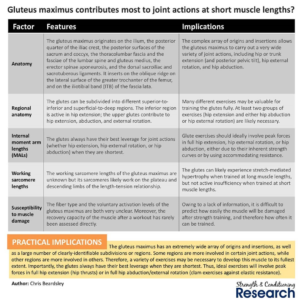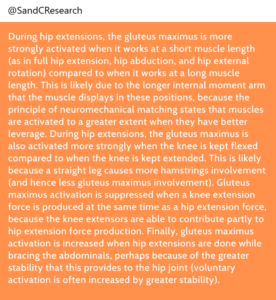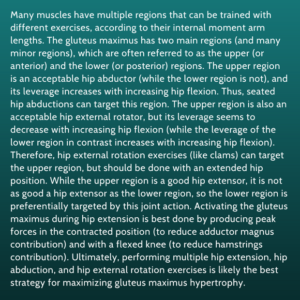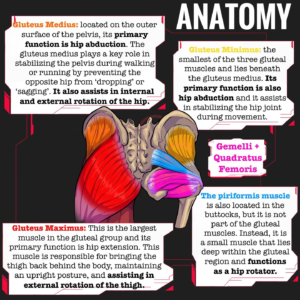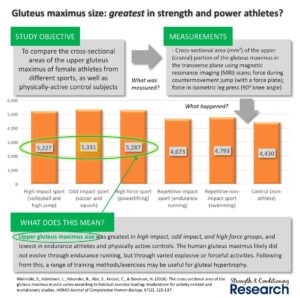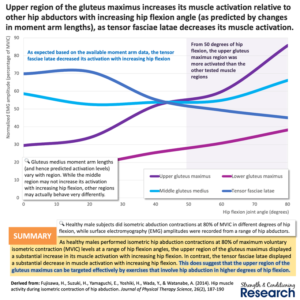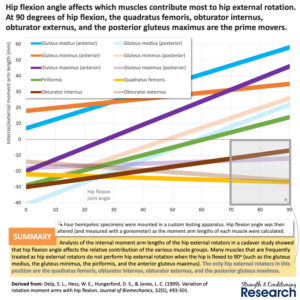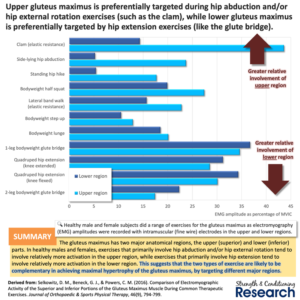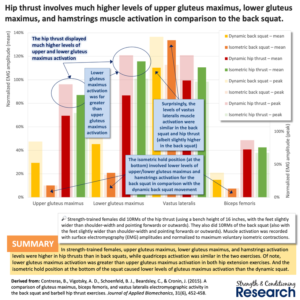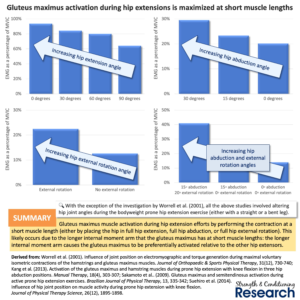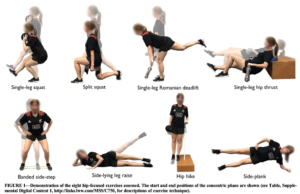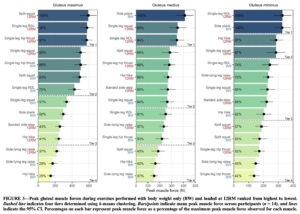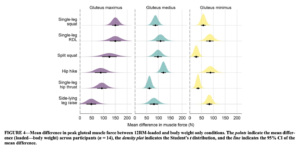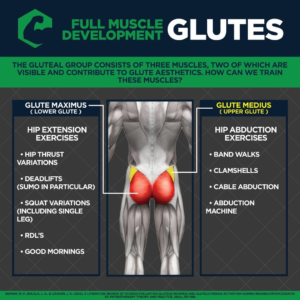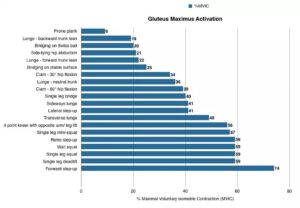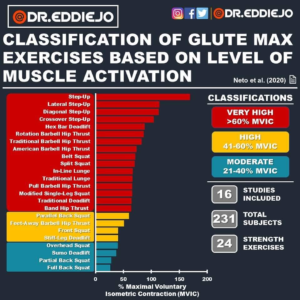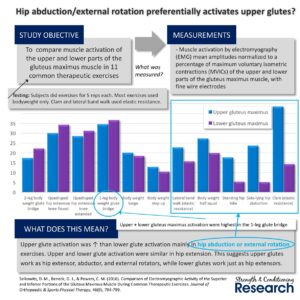GLUTEUS MAXIMUS – RESEARCH
Click on Image to Enlarge
TRAINING
1
MOMENT ARM & EMG STUDIES
GLUTEUS MAXIMUS REGIONS – REVIEW
Gluteus Maximus Regions – Beardsley
– Many muscles have multiple regions that can be trained with different exercises, according to their internal moment arm lengths.
– The gluteus maximus has 2 main regions (+ many minor regions) referred to as upper (or anterior) and lower (or posterior) regions
#1. Upper gluteus maximus
Hip Ab-ductor
– In addition to being a relatively good hip extensor, it is also an acceptable hip abductor (and its leverage increases with increasing hip flexion).
– Therefore, performing hip abduction in a seated or otherwise flexed hip position is quite likely to be useful for training this muscle region.
Hip External Rotator
– The upper gluteus maximus is probably also an acceptable hip external rotator (however, its leverage decreases with increasing hip flexion).
– Thus, performing hip external rotation in an extended hip position is most likely to be useful for training this muscle region.
– Even though the internal moment arm lengths of the upper and lower gluteus maximus regions for hip external rotation are similar, many exercises that involve an element of hip external rotation seem to involve greater levels of upper gluteus maximus activation than lower gluteus maximus activation.
#2. Lower gluteus maximus
Hip Extension
– During hip extension movements that involve the gluteus maximus to a large extent, the lower region is typically more strongly activated than the upper
– Hip extension variations that involve the gluteus maximus are those that minimize the involvement of [1] the adductor magnus, and [2] the hamstrings.
– To minimize the involvement of the adductor magnus, use an exercise that involves peak forces when the hip extensor muscles are shortened. This is because the adductor magnus has good leverage for hip extension when the muscles are long and poor leverage when the muscles are short.
– To minimize the involvement of the hamstrings, use an exercise that involves hip extension with a flexed knee position. This reduces the ability of the hamstrings to produce force through active insufficiency and thereby increases the involvement of the gluteus maximus.
#3. Effects of hip joint angle position on muscle activation
– The gluteus maximus is uniformly activated to a greater degree when it is working at a short length, relative to when it is working at a long length.
– The gluteus maximus functions as a hip extensor, a hip abductor, and a hip external rotator (among other things)
– Its activation during hip extension is maximized when the hip is extended, abducted, and externally-rotated.
– This suggests that exercises that involve peak force production when the muscle is shortened (such as hip thrusts and glute bridges) will be better for training the gluteus maximus than exercises that involve peak force production when the muscle is lengthened (such as squats).
– Activation of the gluteus maximus is very likely maximized at short muscle lengths because that is when it has the longest internal moment arm, relative to the other hip extensors.
– In contrast, when the gluteus maximus is lengthened, its internal moment arm decreases dramatically, while the internal moment arms of the other hip extensors increases.
– The principle of neuromechanical matching: muscles working the same joint are activated in proportion to their leverage for a joint action
#4. Effects of knee joint angle position on muscle activation
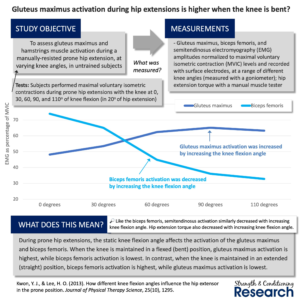 – When the knee is maintained in an extended (straight leg) position during hip extension movements, the hamstrings are very active, and this seems to suppress gluteus maximus activation.
– When the knee is maintained in an extended (straight leg) position during hip extension movements, the hamstrings are very active, and this seems to suppress gluteus maximus activation.
– In contrast, when the knee is maintained in a flexed (bent leg) position during hip extension movements, the hamstrings not very active, and this seems to encourage greater gluteus maximus activation.
– It seems likely that the central nervous system (CNS) recognizes the straight leg position allows hamstrings to contribute to force production more easily due to positions of their muscle fibers on the length-tension relationship, and thereby increases hamstrings activation relative to gluteus maximus activation
– Similarly, it likely recognizes bent leg positions prevent hamstrings from contributing to force production very effectively, and thus increases GMax activation
#5. Effects of combining hip extension with knee extension actions
 – When knee extension force production occurs at the same time as hip extension force production, activation of the GMax is decreased relative to the same hip extension force being produced in isolation. In contrast, the activation of the single-joint quadriceps is increased.
– When knee extension force production occurs at the same time as hip extension force production, activation of the GMax is decreased relative to the same hip extension force being produced in isolation. In contrast, the activation of the single-joint quadriceps is increased.
– It’s unclear why this happens; it seems to result from knee extensors being able to contribute to hip extension force production during multi-joint exercise
– In practice, it suggests that the gluteus maximus is best trained with exercises that involve predominantly or exclusively hip extension (such as deadlifts or back extensions) and not exercises that combine both hip and knee extension at the same time (such as squats).
N.B. An alternative (and potentially more plausible) hypothesis for why gluteus maximus and hamstrings activation are reduced when a knee extension force is applied during hip extensions is that adductor magnus activation is increased. This would be a simpler explanation that does not require complex biomechanical maneuvering, but to date this has not been assessed
#6. Effects of abdominal muscle activation
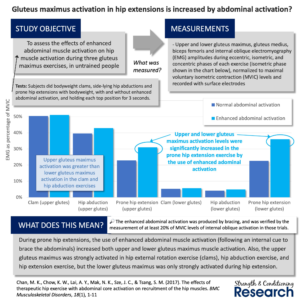 – When the abdominals are deliberately activated during hip extension actions, this increases gluteus maximus muscle activation.
– When the abdominals are deliberately activated during hip extension actions, this increases gluteus maximus muscle activation.
– This may occur because of the greater stability that bracing the abdominals provides to the muscles working at the hip joint.
– When working in a more stable environment, muscles are typically able to achieve higher levels of voluntary activation (motor unit recruitment).
EMG STUDIES
GLUTEUS MAXIMUS-MEDIUS-MINIMUS
– Multiple Exercises
Gluteal Muscle Forces during Hip-Focused Injury Prevention and Rehabilitation Exercises – Collings 2023
Procedure:
– 14 female footballers (18-32 yr old) with at least 3 months of lower limb strength training experience.
Review:
– PhysioTutors.com
– Hip extension–dominant movements (split squat, single-leg squat, RDL, and hip thrust) created similar muscle forces in the gluteus medius and minimus compared to hip abduction movements (hip hike, banded side step, side-lying leg raise). Thus when you want to target the lateral stabilizers of the hip, you can use more functional hip-extension dominant exercises
– The results indicate that for many exercises, the gluteus minimus produced more force compared to the gluteus medius, when the force production was normalized to the muscle size, particularly for hip hikes, side-lying leg raises, and side planks. As the gluteus minimus is more of a hip stabilizer by helping the capsule hold the femoral head in the acetabulum, you can use these exercises to increase local hip stabilization.
– Subjects with gym experience and playing rugby were included and this may not be generalizable to people suffering from hip pathology or injury. The same is true for sex as all players in this study were female.
GLUTEUS MAXIMUS
– Multiple Exercises
Review of studies evaluating gluteus maximus and gluteus medius activation during rehab exercises .
Michael Reiman – 2011
Procedure
– Look at studies that evaluated activation of GMax during rehab exercises; Note: subjects included in this review were healthy
Results for Gluteus Maximus
– the following can affect EMG activity:
(1) trunk position (2) movement direction (3) base of support
– EMG ranged from 74% to 9% MVIC; strength gains are expected for activation levels = or >40% MVIC
· 74% – forward stepup
· 59% to 56% – 1-leg squat; 1-leg RDL; wall squat; retro backward stepup; 1/4 squat
· 49% to 40% – transverse lunge; sideways lunge; lateral stepup; 1-leg bridge
· 39% to 34% – clam 60º hip flexion; lunge neutral trunk; clam 30º hip flexion
· 25% to 19% – bridging on stable surface; lunge forward lean; side lying hip ab-duction; bridging on a swiss ball; lunge backward lean
· 9% – prone plank
GLUTEUS MAXIMUS
– Multiple Exercises
Glute Max Activation during Common Strength and Hypertrophy Exercises – Review – 2020 – Neto
Procedure
– GMax activation levels during strength exercises that incorporate hip extension and use of external load
Results
– the following factors might directly influence GMax activation
(1) External load
(2) movement velocity
(3) level of fatigue
(4) mechanical complexity of the exercise
(5) need for joint stabilization
– Step-up may elicit the highest level of Gmax activation possibly due to the stabilization requirement
| Classification | Activation | Exercise | Average (%MVIC) |
|---|---|---|---|
| 1º | Very high | Step-Up | 169.22 ± 101.47 |
| 2° | Very high | Lateral Step-Up | 114.25 ± 54.74 |
| 3° | Very high | Diagonal Step-Up | 113.21 ± 43.54 |
| 4° | Very high | Crossover Step-up | 104.19 ± 33.63 |
| 5° | Very high | Hex Bar Deadlift | 88 ± 16 |
| 6° | Very high | Rotation BB Hip Thrust | 86.18 ± 34.3 |
| 7° | Very high | Traditional BB Hip Thrust | Lower GM: 69.5/Upper GM: 86.7 |
| 8° | Very high | American BB Hip Thrust | Lower GM: 57.4 ± 34.8/ Upper GM: 89.9 ± 32.4 |
| 9° | Very high | Belt Squat | 71.34 ± 29.42 |
| 10° | Very high | Split Squat | 70 ± 15 |
| 11° | Very high | In-line Lunge | 67 ± 11 |
| 12° | Very high | Traditional Lunge | 66 ± 13 |
| 13° | Very high | Pull Barbell Hip Thrust | 65.87 ± 23.28 |
| 14° | Very high | Modified Single-leg Squat | 65.6 ± 15.1 |
| 15° | Very high | Traditional Deadlift | 64.50 ± 41.72 |
| 16° | Very high | Band Hip Thrust | Lower GM: 49.2 ± 26.5/ Upper GM: 79.2 ± 29.9 |
| 17° | High | Parallel Back Squat | 59.76 ± 22.52 |
| 18° | High | Feet-away Barbell Hip Thrust | 51.38±17.93 |
| 19º | High | Front Squat | 40.54 ± 4.73 |
| 20° | High | Stiff-Leg Deadlift | 40.5 ± 18.8 |
| 21° | Moderate | Overhead Squat | 39.75 ± 29.91 |
| 22° | Moderate | Sumo Deadlift | 37 ± 28 |
| 23° | Moderate | Partial Back Squat | 28.16 ± 10.35 |
| 24° | Moderate | Full Back Squat | 26.56 ± 12.33 |
UPPER GLUTEUS MAXIMUS, GLUTEUS MEDIUS, TFL
– Multiple Exercises
Which Exercises Target the Gluteal Muscles While Minimizing Activation of the Tensor Fascia Lata? – 2013 – Selkowitz
Procedure
– determine which exercises are best for activating the GMed and the superior portion of the GMax, while minimizing activity of the tensor fascia lata (TFL).
Fine Wire Electrodes
– SUP-GMAX: superior and lateral to midpoint of a line drawn b/n the posterior superior iliac spine and posterior greater trochanter.
– GMED: inserted 2.5 cm distal to the midpoint of the iliac crest (ie, middle portion).
– TFL: inserted distal and slightly lateral to the anterior superior iliac spine and medial and superior to the greater trochanter.
Results
| Exercise | Tensor Fascia Lata | Gluteus Medius | Superior Gluteus Maximus |
|---|---|---|---|
| Side-lying hip abduction | 32.3 ± 13.1 | 43.5 ± 14.7 | 23.7 ± 15.3 |
| Bilateral bridge – Hip Thrust | 8.2 ± 7.4 | 15.0 ± 10.5 | 17.4 ± 11.9 |
| Clam | 11.4 ± 11.4 | 26.7 ± 18.0 | 43.6 ± 26.1 |
| Hip hike | 31.4 ± 14.4 | 37.7 ± 15.1 | 17.7 ± 15.2 |
| Lunge | 21.6 ± 14.5 | 19.3 ± 12.9 | 20.1 ± 11.1 |
| Quadruped hip extension, knee extending | 15.6 ± 9.3 | 27.3 ± 14.9 | 28.5 ± 16.6 |
| Quadruped hip extension, knee flexed | 18.7 ± 10.6 | 30.9 ± 15.2 | 30.1 ± 12.5 |
| Sidestep | 13.1 ± 7.1 | 30.2 ± 15.7 | 27.4 ± 16.7 |
| Squat | 4.6 ± 3.8 | 9.7 ± 7.3 | 12.9 ± 7.9 |
| Step-up | 21.4 ± 11.4 | 29.5 ± 14.9 | 22.8 ± 15.6 |
| Unilateral bridge – Hip Thrust | 18.1 ± 12.9 | 30.9 ± 20.7 | 34.6 ± 16.8 |
